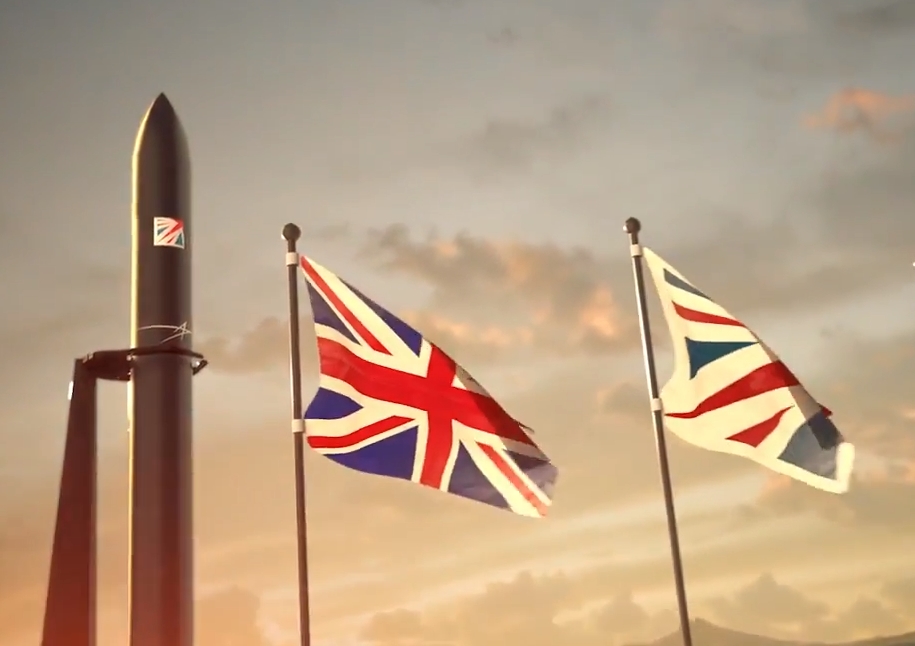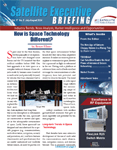A ‘National Space Strategy’ for the UK?
by Martin Jarrold
London, UK, October 12, 2021--As facilitated by GVF, the editor-in-chief of this publication, Virgil Labrador, will be presenting a business outlook analysis during the SatExpo Summit at CABSAT 2021 and asking, “What are satellite operators betting on?” With the digitalization of all industries, and changes in the way we live, work, learn, communicate and consume entertainment, Virgil Labrador will examine how satellite operators can make sure they are developing the right offerings and targeting the right sectors to compete and thrive in an increasingly crowded market, a market which continues to thrive in GEO, expand in MEO, and evolve in LEO.
One of the LEO satellite mega-constellations centrally featured in discussion during a recent webinar in the GVF-SEG series was OneWeb. Launching its first satellites in February 2019 and continuing to grow the constellation until March 2020, the company – due to financial difficulties caused by the Covid-19 pandemic – filed for Chapter 11 bankruptcy protection. OneWeb maintained its satellite operations center for its already orbited satellites while the bankruptcy process determined the disposition of corporate assets. The company exited bankruptcy in November 2020, after being sold to the Government of the United Kingdom and Bharti Global. Since then, having secured additional investments from SoftBank, Hughes Network Systems, Eutelsat, and Hanwha Systems, OneWeb continues to orbit its planned satellites, with the constellation due for completion in 2022, though services between 50° N latitude and the north pole will start sooner.
Why this recap on the status of OneWeb? After all it is only one of a number of NGSO constellations being built. It is because the investment in the company by the government of the UK has more recently been placed into a broader context, a context established by publication of the first ever UK National Space Strategy (NSS). Released towards the end of September, this document lays out Government plans, in the words of Prime Minister Boris Johnson, to put the UK in the “front rank of the global space industry”
 The GVF webinar, The UK Space Landscape: A Force for Disruptive Change, was broadcast over Zoom on 30 September, just days after the NSS was published. (The webinar recording is available on-demand at https://gvf.org/webinar/the-uk-space-landscape-a-force-for-disruptive-change/.) The webinar provides a detailed analysis of the newly emergent opportunities following on from the publication of the Strategy, although the document has not been met without some considerble critique, as explored in the webinar discussion between panelists who, for different reasons, are at the cutting-edge of the country’s accelerating space industry advances.
The GVF webinar, The UK Space Landscape: A Force for Disruptive Change, was broadcast over Zoom on 30 September, just days after the NSS was published. (The webinar recording is available on-demand at https://gvf.org/webinar/the-uk-space-landscape-a-force-for-disruptive-change/.) The webinar provides a detailed analysis of the newly emergent opportunities following on from the publication of the Strategy, although the document has not been met without some considerble critique, as explored in the webinar discussion between panelists who, for different reasons, are at the cutting-edge of the country’s accelerating space industry advances.
Responsible for holding the UK Government (i.e., the Executive) to account is Parliament (i.e., the legislature). The legislature has within its committee structures an All-Party Parliamentary Space Committee, the Vice-Chair of which, Mark Garnier MP, joined the webinar discussion, along with: Nick Flitterman, Managing Partner of Portland Advisers (the Moderator); Chris McLaughlin, Chief of Government, Regulatory & Engagement, OneWeb; Gary Wade, Future Transformative Programme Lead, Satellite Applications Catapult; and, Anthony Baker, CEO, SatelliteVu. This comprised a formidable team in conveying how the United Kingdom is now leveraging on its long history in space-related activity and is now aiming to build itself into a key global center for a wide range of space business opportunities.
Their further perspectives – that of (1) the LEO mega-constellation with British government investment, (2) of an organization bringing together industry and academia to promote capability innovation in the UK’s satellite technologies, and (3) a start-up Earth observation company focused on high resolution thermal imagery – provided much food for thought and a continuing dialogue at a time when the global space and satellite business environment is rapidly expanding, creating opportunity to compete in what is something of a new space race.
Illustrated by the increasing number of smaller space-active nations – for which the establishment of a national space agency and development of a space presence has become, amongst other objectives, a new means of exhibiting national power, or at least exhibiting the aspiration to achieve it – awareness of the strategic significance of space as having a vital role in the functioning of a modern economy, of an effective military, and of various services critical to society, has become entrenched.
The UK, contrary to what the less well-informed may think, is not, however, one of these smaller and only recently space-active nations. It has a long and significant history in space activities, with limitations to the full exploitation of its potential usually being down to lack of consistent governmental budgetary commitment. Until 1971 the UK had its own satellite launch capacity based in Australia, with the Black Arrow rocket’s final flight orbiting to LEO the Prospero satellite in that year. Frequent lack of funding commitment led to the UK being lost to development of more major space capabilities, except with the more obvious example of military communications and the Skynet program. But the UK has been a leader in the realms of developing a world-class space science base and leveraging this to enable domestic satellite technology development (e.g., Surrey Satellite Technology, SSTL, successful academic spin-off and now part of Airbus Group; and more recently, on the ground segment side in the context of a multi-orbit satellite environment, the example of Isotropic Systems) and contribute to European consortia for scientific and commercial satellite construction.
The governments of the older and bigger space-active nations have always put money on the table when Earth observation and imaging, weather forecasting, military strategy and tactics, government intelligence gathering and surveillance, etc., were concerned. The UK has usually been behind that global curve…, but maybe this is about to change.
I mentioned above that the NSS has been critiqued. Ironically, one reason is precisely because it is the product of a not insignificant joint effort of many parts of government (around ten major departments and agencies), the respective interests of which must be reconciled. If the reconciliation works, despite spanning the many policy interest areas, the UK will have the taken the first steps to achieving a comprehensive and integrated plan for national space activity. However, successfully spanning and reconciling different departmental agenda is not enough. The NSS must also guarantee effective implementation of measures to enable the standalone strategic development of the business of space. This would be founded on an economic model wherein, for example, entrepreneurs (not the billionaire type, but the seeking for seed funding type) can get coordinated, multi-faceted, government-backed A-to-Z support (i.e., not just in regulatory matters) for bringing to fruition space business ideas that are not necessarily a part of the policy agenda of any of the NSS contributing departments/agencies, but which have their own inherent merits. Decision-making within the administration of such a model will probably need to be undertaken by the scientists who understand the whys and wherefores of space business project proposals, rather than by government officials.
The NSS has perhaps offered up more questions than it answers, and those answers need more specificity and substance. However, as recognized during The UK Space Landscape: A Force for Disruptive Change webinar, the NSS is a good start.
Some of these pending questions are: Where to next? What precise direction is indicated on the roadmap of the nation’s space landscape? And will government be focused on facilitating expansion of a space-friendly finance environment to bring in the money to support bigger programs of space-related capacity-building and research and development? How and who will decide on the metrics to be used to gauge the success of this capacity-building and R&D, and therefore measure if the UK is indeed building “one of the most innovative and attractive space economies in the world”.
We know that the UK Ministry of Defence (MoD) is to publish its own separate space strategy, not surprising given that the UK’s space business history has had a strong slant towards military communications, as alluded to above with reference to the Skynet program. The NSS is certainly strong on advocacy for integrating civil and military space, so we must await the MoD’s take on this.
From my perspective, working for GVF, a UK-registered entity, I am keen to understand if the NSS brings any, yet unrealized, implications for the UK’s longer-term relations with the European Space Agency (ESA). [A note to readers – The European Union and European Space Agency are separate institutions and the UK’s “Brexit” from the EU did not change its membership of ESA.] GVF, working with various of its member companies, has partnered with ESA on projects including, most recently, with the Danish start-up QuadSAT with its drone-based antenna testing technology.
The UK’s National Space Strategy document is just an early step on what we must hope becomes a clearly drafted roadmap, and there will be more to say and write about it in due course.
I haven’t written much here about CABSAT. I won’t be in Dubai, but various GVF colleagues and representatives of GVF member companies will be supporting the exhibition and the SatExpo Summit. At the GVF booth you’ll find my excellent colleagues: Riaz Lamak, GVF’s Lead on Humanitarian Assistance & Disaster Response and who also delivers GVF Training Certification; and Mazen Nassar, who is also a GVF Training Certification Instructor.
Until next time… Keep well, stay safe!
--------------------------------------------
 Martin Jarrold is Vice-President of International Program Development of GVF. He can be reached at: martin.jarold@gvf.org
Martin Jarrold is Vice-President of International Program Development of GVF. He can be reached at: martin.jarold@gvf.org





